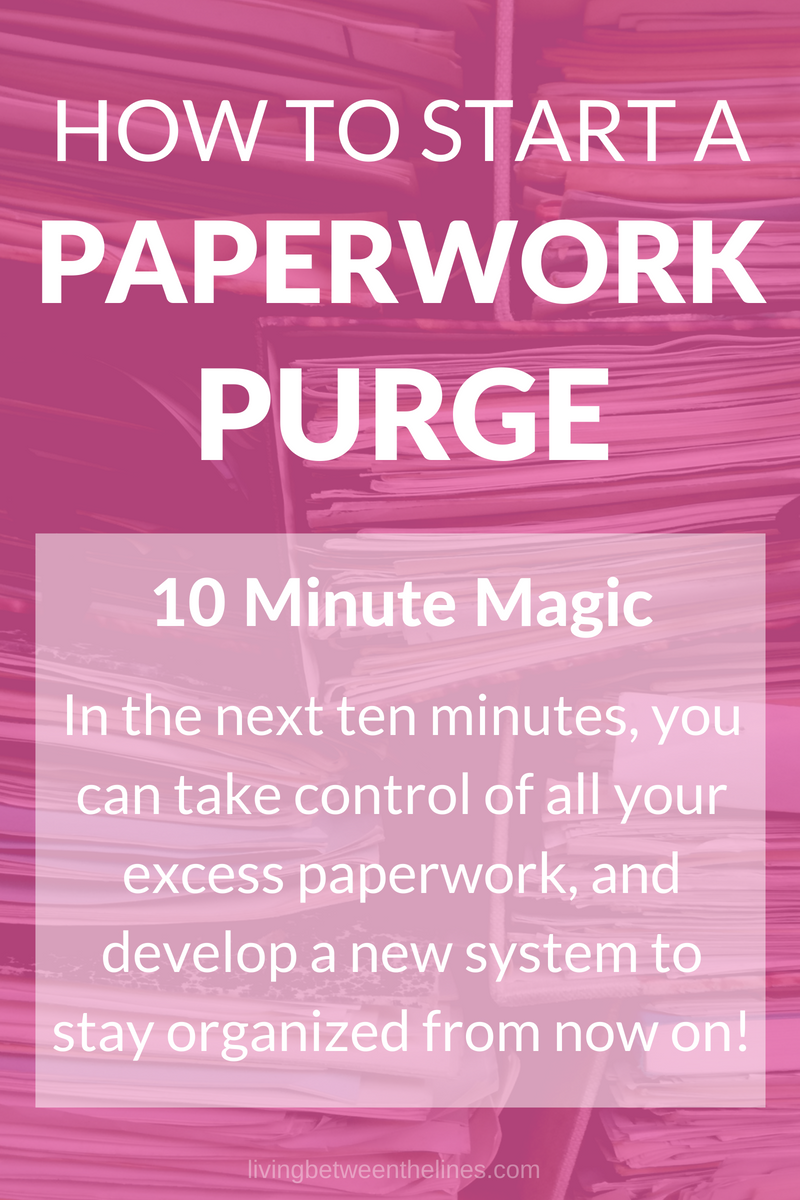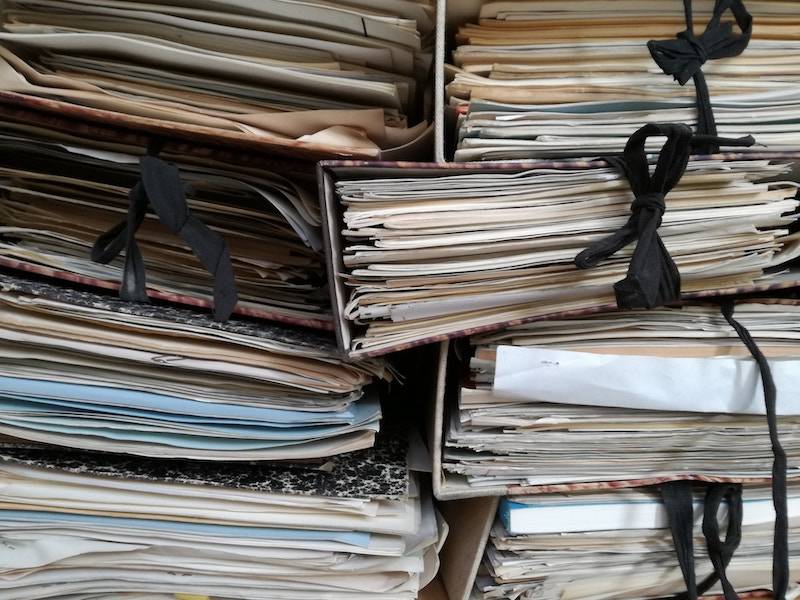When I was in college, managing my papers was always a nightmare. I had tons of handouts and readings to keep straight, and I was always losing them. Once I graduated, bringing home all those papers didn’t help a bit. And then I started work, and suddenly I had huge, unwieldly piles of papers in two places. I needed a paperwork purge, stat.
Paperwork Purge – 10 Minute Magic

Most of us have a paperwork pileup somewhere. Maybe for you it’s a mail pile, or your schoolwork in a desk drawer, or an old, unorganized file box, or a big plastic tote full of old school papers. If you don’t have something like this… congrats! You’re a goddess. Go forth and be radiant.
For the rest of us mortals, a paperwork purge is the answer.
A few posts ago, we talked about decluttering your mind with a brain dump. This week, we’re going to apply those same principles to your space.
Clear the Air
You probably keep a lot of papers you don’t need. Some of these useless documents will be easy to identify. For example, I get tons of credit card offers in the mail that I know I’ll never take advantage of. Those can disappear. Junk mail, as a rule, needs to go right away. So do ads and sales slicks that are old, finished, or expired. If you’re a student, get rid of paperwork from any classes you dropped, presentations that didn’t interest you, or student organizations you’ll never join.
It can be tempting to hold onto things “just in case.” But as you’ll see in the next section, the only things you should keep are papers that either A.) have a strong emotional/personal attachment or B.) will likely be useful in the future. Notice that I said likely and not maybe! But we’ll get there.
For now, if something is clearly junk, destroy it. If you have a shredder, start shredding. If you don’t have a shredder… You should probably get one. But until then, burn old papers in your fireplace like a scorned Victorian woman, or just… I dunno, cut them up with scissors. This is a great way to release pent-up aggression, just FYI.
Sort It Out
Once you’ve destroyed all the papers that are clearly useless, you’ll probably still be left with a mess of documents. This is always the hardest decision to make: ‘Do I really need this?‘
I often find myself attached to silly documents, just in case I (might) (maybe) want to look at them later. That said, I’ve developed a series of questions to help me make the hard decision to throw things away.
If you answer “yes” to any of these questions, keep the paper. If you answer “no” to a question, move to the next question.
- Do I need this document to complete a task?
- Do I use this document regularly?
- Do I foresee a specific use for this paper in the next 12 months?
- Do I have a significant, strong emotional or personal attachment to this document?
- Is this paper the only way for me to access this information?
If you answer “no” to all these questions, you can throw it out. I know it seems harsh, but just get rid of it. The last question is key. Sure, your old notes are nice to keep for reference, but what will take longer: Googling for the answer, or finding that specific day’s notes again? The internet is vast and helpful. Rely on that.
Get To Work
You may stumble across papers you actually need to work with – maybe they’re bills to pay, maybe they’re surveys you actually meant to answer, maybe they’re reminders to make a call. Pull all of the ‘action needed’ papers out of your keep pile, and take a good hard look at them.

If a task will take less than a minute, do it right then. Seriously, do it immediately. If it’s necessary, but will take a little while, add it to your brain dump and keep moving.
The goal here is to knock out all the little tasks you’ve been putting off, and then record the larger requirements in a place that allows you to take action.
If you’re new to 10 Minute Magic, or just found that brain dumping doesn’t really work for you, you’ll need a different strategy. Think practically – how do you actually keep track of the things you need to do? Do you use your email inbox as a to-do list? Send yourself an email. Do you leave yourself sticky note reminders? Grab a pad and a pen. Phone reminders? Set them. Whatever your method is, get these tasks in place so you don’t put them off (again).
Oh, and if you can get rid of a paper once you’ve acted on it, toss it in the shredder and keep on moving.
Papers You’ll Keep
There are plenty of decent reasons to keep papers. Maybe it’s important financial info, maybe it’s a nice letter from a friend, maybe it’s unique reference material that’ll be useful in future schooling or work. There’s nothing wrong with keeping paperwork. It’s just that most people keep entirely too much of it, and organize it poorly – meaning they lose all the value in keeping it at all.
Before you decide how to store and organize your papers, figure out what you’re keeping! There’s not really a one-size-fits-all solution for this. So, think about it, are you keeping mostly:
- Loose sheets of paper?
- Notebooks?
- Oversized documents?
- Delicate documents?
Each of these will have slightly different storage and organization needs. The key with all of these is to give yourself room to grow! While the hope is that you’ll accumulate papers at a slower rate, you’ll still need to keep things here and there. Make sure you’re able to expand, not just accommodate what you already have.
Binders
Binders are the classic way to store project-oriented papers. If you have a three-hole-punch handy, you can easily store related papers in binders. If your projects are finished, choose the smallest binder ring size necessary to hold your content. If your projects are ongoing and you’ll need to add to that binder, choose one with room to grow.
Binders are also great for storing notebooks! Choose large ring sizes to stack multiple, related notebooks in a single binder. You can organize by subject, semester, etc. Binders are easier to store than notebooks, and you can make note of what each binder contains on the spine – a luxury you’re not afforded with spiral-bound notebooks.

Expanding or Accordion Files
I used to carry one of these around in high school, because I’m a giant nerd. You can get anything from a small, five-folder fabric file to a huge accordion file box that can hold hundreds – maybe thousands – of pages.
I find that these are especially useful for students. Get a file for each semester or year, label the tabs with the classes you’re taking, and use them to store your syllabus, assignment prompts, and reading printoffs.
For the non-students among us, these can still be a great way to organize based on time. Keep one for each year or financial quarter, and add to it as needed.
Accordion files are best as a way of tracking projects with an end date or archiving older papers, not storing neverending projects. You’ll run out of room eventually, and then keeping track of two accordion files becomes extra work. For long-term, ongoing needs, consider…
File Boxes
These are a personal favorite of mine. File boxes are like file cabinets that don’t cost $200 and weigh 100 pounds. They’re durable, portable, and can help protect delicate documents from the elements, like light and moisture. File them up with hanging files – tabbed, for easy labelling – and sort your papers as needed.
Depending on how much you’re keeping, you might want separate boxes for different subjects, projects, or times in your life. Choose boxes that will stack nicely for easy storage. They’re usually light and easy to move around, which is a huge advantage over file cabinets.
Other
This won’t apply to 99% of you. But I worked in a map library for four years, which gives me a lot of experience with some very unconventional documents, and I’d love to pass that knowledge on to anyone who needs it.
For oversized papers, you don’t actually have a lot of options. Most storage is designed for 8 ½” x 11″ documents. That said, my time in the map library taught me a lot about rolling oversized sheets of paper. If you need a cheap solution, carboard shipping tubes will do the trick. Otherwise, look into dedicated document tubes. (Bonus – the ones with a shoulder strap make you feel like you’ve just stolen the Declaration of Independence.)
For extra-delicate documents, like art or older papers, you’ll always want to look for solutions labelled ‘archival’. These products will last without degrading, and won’t harm delicate paper. You’re best off storing these lying flat in a document box. Encase what you can in a sheet protector, and use archival tissue paper to separate everything you stack.
Sticking With It
Naturally, the first step to sticking with your new system is making sure you have room to grow. No matter what supplies you use to stay organized, make sure there’s space to add more documents as needed.
The next step is to decide how often you’ll want to assess your paperwork. For you, it might make sense to just organize and file papers as you get them. But it could be better to tackle several days – or even weeks – worth of documents at a time. Only you can answer this question, but the most important thing is to be realistic. If you won’t actually take care of your papers the moment you get them, there’s no sense planning as if you will. And if you know leaving papers to pile up will mean leaving them to pile up for months, don’t give yourself any leeway!
As difficult as it is, you need to find that perfect middle ground. A good strategy for this is to set a reminder in your phone for a few repetitions of your perfect intreval – whether that’s every day, every week, etc. If you find that your new schedule isn’t working out, adjust as needed!
Final Notes
The long and short of it is that you’re probably keeping too much paperwork lying around, but it’s pretty easy to fix. Your main challenges will be tackling the backlog and developing a new system.
As you address your buildup of documents, you might encounter papers you’re unsure about purging. Get rid of anything unnecessary immediately, and assess the rest based on what you need and why you need it – you’ll likely find you’re holding on to some silly stuff. If any of your paperwork requires immediate action, do it now or schedule it for later with a reminder.
Once you’ve sorted your paperwork, choose an organizational scheme that works for you, your documents, and your space. Make sure you have good organization – there’s no use keeping a paper if you’ll never be able to find it when you need it. And make sure you have room to grow!

Do Right Now
- Gather all your stray paperwork into one big pile for sorting
- Figure out a way to destroy unnecessary papers safely
- Decide how much time you’re willing to devote to papers that need attention, and how you’ll set up reminders for the rest
- Think about the type of papers you’ll need to keep, how you’ll need to organize them, and what space you have to keep them in
- Get started!


